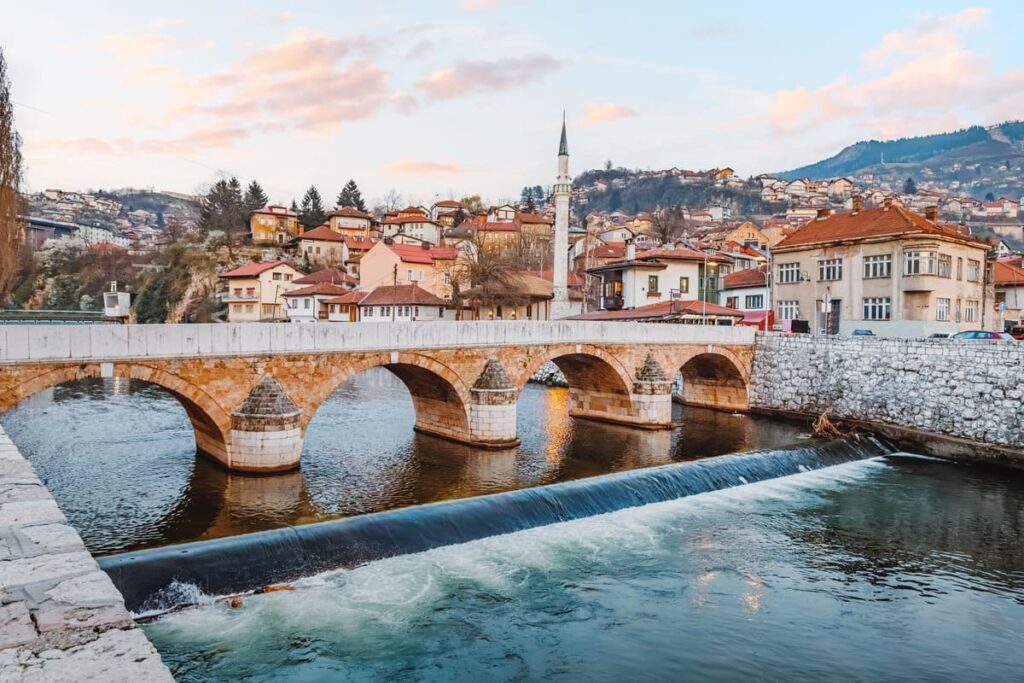Travel Guide
This Underrated European Capital Set To Surge In Popularity This Summer
When you think of a European city break, it’s probably Paris and its grand Haussmann-era boulevards, London’s skyscraper-lined Thames riverfront, or maybe Milan’s glamorous feel and haute cuisine that come to mind, not an offbeat Sarajevo.
In fact, you might be wondering where that even is.


The (much) overlooked capital of Bosnia and Herzegovina, a criminally-underrated country itself, Sarajevo is making some waves recently, continuing to see an uptick in arrivals after hitting its target 1.5 million overnights in 2024 (a 26.6% year-on-year increase).
Unheard-of as it may be on our side of the pond, it’s never been more popular than it is at this very moment among Europeans, with Turks, Croats, Serbs, and Germans leading the way—and it’s high time we looked into some of the reasons why.
Why Are Tourists Suddenly Flocking Into Sarajevo?


Located near the geometric center of Bosnia and Herzegovina, which is only fitting for a capital, Sarajevo is one of Europe’s most diverse capitals, home to Muslims, Orthodox Christians, and Catholics, a cultural hub of the first order, and perhaps the continent’s most unsung destination, at that.
It has a rich (albeit complex) history, encompassing periods of Ottoman and Austrian control, and for that reason, it is often described as a place where cultures clash:
Istanbul may be the most famous city to (literally) straddle two continents, but it’s in Sarajevo you’ll find ornate medieval mosques and their adjacent bazaars within short walking distance of imposing, 16th-century Orthodox temples and Gothic churches.


Bosnia is a multi-faith nation born out of the need to let go of past differences and grievances, and though that hard-fought peace shows its cracks every now and then, nowhere else in the Balkans will you see a melting pot as fascinating as this.
Medieval Mosques, Picturesque Bridges & Cobbled Lanes
Taking a stroll around the riverside Old Town, with its cobbled streets, and a plethora of tea shops and cozy cafes, you’ll come upon majestic mosques, like Gazi Husrev-beg, a centerpiece of Ottoman architecture dating back to the 16th-century, but also Orthodox temples and Gothic churches.
Also built in the 16th century, the Byzantine-inspired Church of the Holy Archangels is a testament to Sarajevo’s deeply ingrained sense of multiculturalism. It serves the local ethnically Serbian community and is among the capital’s oldest religious sites.


Interestingly enough, a short 6-minute walk away is the towering Sacred Heart Cathedral, a Neo-Gothic marvel featuring a marble-cut altar and intricate stained glass designs. It caters primarily to the ethnically Croatian population of Sarajevo and is Bosnia’s largest cathedral.
We know World War I is not as widely-taught in schools across America as its much more catastrophic follow-up, but if you were ever curious as to how the sad tale of wounded soldiers in trenches and bayonet bearers started, look no further than Sarajevo’s Latin Bridge:
Discover Sarajevo’s War Wounds


Yep, WWI started not over some disagreement in palatial chambers in Germany but right there on the city’s oldest stone pedestrian crossing, spanning the otherwise peaceful Miljacka River.
This is where Archduke Franz Ferdinand was assassinated in 1914, an event that many Historians regard as having sparked the Europe-wide conflict, and besides crossing the bridge to soak up the eerie atmosphere yourself, you can visit a nearby museum where you can learn all about it in detail.
Unfortunately, Sarajevo’s standing in the Annals of Time did not take a turn for the better in the same century, as in the 90s, it would be rocked by gruesome events and instability once more.
You’ve heard of the Bosnian War, right?


While spared the same level of human tragedy that brought smaller towns like Srebrenica and Mostar to their knees, the capital endured a 4-year siege, and it, too, has its dead to mourn.
For those of you who are into Dark Tourism, there are still some schools, hospitals, and cultural landmarks that carry bullet holes and other war scars, most notably the National Library, an Islamic-inspired brick-and-concrete palace right on the water that was nearly burned to the ground.
Yet another popular attraction is the Tunnel of Hope: despite its name, it’s in fact a war tunnel used to smuggle people and supplies over the battlefront during the siege, and it now hosts a museum.
However, not all is doom and gloom.


For two of the best sunset views in town, either take the cable car from Stari Grad (Old Town) to Trebević Mountain (costing roughly $18), or hike a short 15 minutes from the center, up to the Yellow Fortress, a castle perched atop one of Sarajevo’s many hills.
This one’s free.
From both viewpoints, you’ll be rewarded with sweeping views of the minaret and belfry-dotted townscape, the landmark-lined meander that is Miljacka, and the lush greenery all around it.
One Of The Cheapest European Capitals


We’d go out of our way to visit Sarajevo any day, regardless of local prices, but it certainly helps that everything from food to accommodation to transportation is shockingly-affordable.
If you’re truly on a strict budget, you can sample delicious local delicacies like Bosnian ćevapi, hand-mixed mince meat formed into a funnel, often served with spices and flatbread, for around $5 in most Old Town eateries, and the same goes for börek pastries, chicken soup with sour cream, and the list goes on.
Even small luxuries in Sarajevo won’t exactly break the bank:


For instance, Dveri is a well-reputed Old Town restaurant, and a quite touristy one at that, popular for its homemade borscht and beef goulash, and a range of rakija flavors (the local spirit, for those that are unaware).
On average, dining here will set you back by around $11–$16 by ordering a main dish.
Across from the City Hall, Inat Kuća is equally famous for its modern twist added to some Bosnian classics, and its homegrown wine and hearty stews won’t run you up by more than $16 for a sit-in lunch with river views.


After the second stew, you might realize Bosnian food, tasty as it may be, isn’t exactly sitting well on your stomach, so if you’re ever in fancy of a Balkan-Asian fusion, make sure Mala Kuhinja is on your list, or the upscale trattoria Tavola, right in the city center.
Looking for a place to stay? Sarajevo has an extensive offer of accommodations, ranging from budget to luxury, but if you find yourself somewhere in the middle, there are entire, fully-furnished apartments are available on Booking.com from only $48 per night for 2 adults.
This Is How Authorities Are Improving Sarajevo For Tourists In 2025


You get the gist of it: Sarajevo (and Bosnia as a whole) is very cheap, it’s incredibly-beautiful, and it’s yet to be ruined by the same crowds that have made Italy’s Amalfi, or the French Riviera a living hell.
Sarajevo International Airport (SJJ), serviced by low-cost flights from all over Europe and select Middle Eastern destinations, has already reported a 44% uptick in passengers this year, as confirmed by Statistika, so it’s been gaining traction.
You better get there before it’s too late, as this gem won’t stay hidden for long.


On top of that, authorities in the capital are investing heavily in making Sarajevo better-connected, and more tourist-friendly: the small airport has now expanded to host flights from major hubs like Dubai, Riyadh, and Kuwait, and the Old Town is undergoing revitalization.
It’s not uncommon for historic centers in the Balkan Peninsula to be a little rundown, given local government’s terrible track record of protecting monuments and material heritage, but in Sarajevo’s case, significant efforts have been made to restore its pre-war glory.


Reconstructions aside, it’s seen the opening of new museums, like Sevdah Art House, both an art exhibit and a cafe with an emphasis on sevdalinka, Bosnian folk music, and even the buzzing Obala Maka Dizdara, a pedestrian promenade, is undergoing renovation.
On top of that, for all the cycling enthusiasts out there, a new, official bike path connecting Dubrovnik, in Croatia, to Sarajevo has just opened.
The 217-mile route has stops in beautiful mountain villages, the city of Mostar, famous for its arched Ottoman bridge, and scenic lakes before reaching the Miljacka River valley, where Sarajevo lies.


Getting To Bosnia From America
Flying from the United States, the easiest way to reach Sarajevo is touching down first in a larger transit airport, like Istanbul (IST), Vienna (VIE), Frankfurt (FRA), or Munich (MUC), and from there, board a low-cost flight to the Bosnian capital.
Prices for an intra-Europe flight to Sarajevo (SJJ) start from only $40, and cities like Vienna or Budapest, served by budget carriers Wizz Air and Ryanair, tend to offer the lowest fare.
Alternatively, you may reach it by bus from neighboring countries that host U.S. flights, like Serbia or Croatia, for equally-cheap prices, or driving.
Ready For Your Trip? Check The Latest Entry Requirements For Your Destination Here
↓ Elevate Your Travel↓
Sign Up Now For Travel Off Path Premium! No ads, VIP Content, Personal Travel Concierge, Huge Savings, Daily Deals, Members Forum & More!


✈️Join Our Travel Off Path Community Forum: Where travelers unite, ask questions, share experiences and even find like-minded travel buddies!
SUBSCRIBE TO OUR LATEST POSTS
Enter your email address to subscribe to Travel Off Path’s latest breaking travel news, straight to your inbox.
This article originally appeared on TravelOffPath.com
Opinions expressed here are the author’s alone, not those of any bank, credit card issuer, hotel, airline, or other entity. This content has not been reviewed, approved or otherwise endorsed by any of the entities included within the post.

